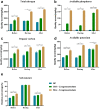Soil microbial diversity and functional capacity associated with the production of edible mushroom Stropharia rugosoannulata in croplands
- PMID: 36213510
- PMCID: PMC9536307
- DOI: 10.7717/peerj.14130
Soil microbial diversity and functional capacity associated with the production of edible mushroom Stropharia rugosoannulata in croplands
Abstract
In recent years, a rare edible mushroom Stropharia rugosoannulata has become popular. S. rugosoannulata has the characteristics of easy cultivation, low cost, high output value, and low labor requirement, making its economic benefits significantly superior to those of other planting industries. Accumulating research demonstrates that cultivating edible fungus is advantageous for farming soil. The present experiment used idle croplands in winter for S. rugosoannulata cultivation. We explored the effects of S. rugosoannulata cultivation on soil properties and soil microbial community structure in paddy and dry fields, respectively. We cultivated S. rugosoannulata in the fields after planting chili and rice, respectively. The results showed that Chili-S. rugosoannulata and Rice-S. rugosoannulata planting patterns increased the yield, quality and amino acid content of S. rugosoannulata. By analyzing the soil properties, we found that the Chili-S. rugosoannulata and Rice-S. rugosoannulata cropping patterns increased the total nitrogen, available phosphorus, soil organic carbon, and available potassium content of the soil. We used 16s amplicons for bacteria and internal transcribed spacer (ITS) region for fungi to analyze the microbial communities in rhizosphere soils. Notably, S. rugosoannulata cultivation significantly increased the abundance of beneficial microorganisms such as Chloroflexi, Cladosporium and Mortierella and reduce the abundance of Botryotrichumin and Archaeorhizomyces. We consider S. rugosoannulata cultivation in cropland can improve soil properties, regulate the community structure of soil microorganisms, increase the expression abundance of beneficial organisms and ultimately improve the S. rugosoannulata yield and lay a good foundation for a new round of crops after this edible mushroom cultivation.
Keywords: Functional analysis; Soil bacterial communities; Soil fungal communities; Soil physicochemical properties; Stropharia rugosoannulata.
©2022 Tang et al.
Conflict of interest statement
The authors declare there are no competing interests.
Figures







Similar articles
-
Effects of an efficient straw decomposition system mediated by Stropharia rugosoannulata on soil properties and microbial communities in forestland.Sci Total Environ. 2024 Mar 15;916:170226. doi: 10.1016/j.scitotenv.2024.170226. Epub 2024 Jan 26. Sci Total Environ. 2024. PMID: 38280599
-
Effects of wine-cap Stropharia cultivation on soil nutrients and bacterial communities in forestlands of northern China.PeerJ. 2018 Oct 9;6:e5741. doi: 10.7717/peerj.5741. eCollection 2018. PeerJ. 2018. PMID: 30324022 Free PMC article.
-
Effects of the rice-mushroom rotation pattern on soil properties and microbial community succession in paddy fields.Front Microbiol. 2024 Jul 24;15:1449922. doi: 10.3389/fmicb.2024.1449922. eCollection 2024. Front Microbiol. 2024. PMID: 39113843 Free PMC article.
-
Synergies between Carbon Sequestration, Nitrogen Utilization, and Mushroom Quality: A Comprehensive Review of Substrate, Fungi, and Soil Interactions.J Agric Food Chem. 2025 Jun 11;73(23):14144-14157. doi: 10.1021/acs.jafc.5c02295. Epub 2025 May 23. J Agric Food Chem. 2025. PMID: 40406890 Review.
-
Nutritional and Therapeutic Potential of Stropharia rugosoannulata and Macrolepiota procera: From Composition to Health-Promoting Effect.J Fungi (Basel). 2025 Mar 27;11(4):259. doi: 10.3390/jof11040259. J Fungi (Basel). 2025. PMID: 40278080 Free PMC article. Review.
Cited by
-
Microbial Community Response and Assembly Process of Yellow Sand Matrix in a Desert Marginal Zone Under Morchella Cultivation.Microorganisms. 2025 Apr 16;13(4):921. doi: 10.3390/microorganisms13040921. Microorganisms. 2025. PMID: 40284757 Free PMC article.
References
Publication types
MeSH terms
Substances
Supplementary concepts
LinkOut - more resources
Full Text Sources

